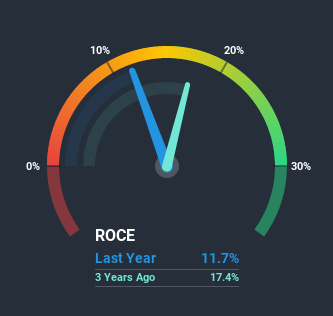Here's What To Make Of Sprouts Farmers Market's (NASDAQ:SFM) Returns On Capital

Want to participate in a short research study? Help shape the future of investing tools and earn a $40 gift card!
If we want to find a potential multi-bagger, often there are underlying trends that can provide clues. Ideally, a business will show two trends; firstly a growing return on capital employed (ROCE) and secondly, an increasing amount of capital employed. Put simply, these types of businesses are compounding machines, meaning they are continually reinvesting their earnings at ever-higher rates of return. However, after briefly looking over the numbers, we don't think Sprouts Farmers Market (NASDAQ:SFM) has the makings of a multi-bagger going forward, but let's have a look at why that may be.
Understanding Return On Capital Employed (ROCE)
For those who don't know, ROCE is a measure of a company's yearly pre-tax profit (its return), relative to the capital employed in the business. Analysts use this formula to calculate it for Sprouts Farmers Market:
Return on Capital Employed = Earnings Before Interest and Tax (EBIT) ÷ (Total Assets - Current Liabilities)
0.12 = US$269m ÷ (US$2.9b - US$547m) (Based on the trailing twelve months to March 2020).
So, Sprouts Farmers Market has an ROCE of 12%. On its own, that's a standard return, however it's much better than the 7.1% generated by the Consumer Retailing industry.
View our latest analysis for Sprouts Farmers Market
Above you can see how the current ROCE for Sprouts Farmers Market compares to its prior returns on capital, but there's only so much you can tell from the past. If you'd like to see what analysts are forecasting going forward, you should check out our free report for Sprouts Farmers Market.
So How Is Sprouts Farmers Market's ROCE Trending?
On the surface, the trend of ROCE at Sprouts Farmers Market doesn't inspire confidence. Over the last five years, returns on capital have decreased to 12% from 17% five years ago. Although, given both revenue and the amount of assets employed in the business have increased, it could suggest the company is investing in growth, and the extra capital has led to a short-term reduction in ROCE. If these investments prove successful, this can bode very well for long term stock performance.
What We Can Learn From Sprouts Farmers Market's ROCE
While returns have fallen for Sprouts Farmers Market in recent times, we're encouraged to see that sales are growing and that the business is reinvesting in its operations. These trends are starting to be recognized by investors since the stock has delivered a 6.8% gain to shareholders who've held over the last five years. So this stock may still be an appealing investment opportunity, if other fundamentals prove to be sound.
Sprouts Farmers Market does have some risks, we noticed 4 warning signs (and 1 which makes us a bit uncomfortable) we think you should know about.
For those who like to invest in solid companies, check out this free list of companies with solid balance sheets and high returns on equity.
This article by Simply Wall St is general in nature. It does not constitute a recommendation to buy or sell any stock, and does not take account of your objectives, or your financial situation. We aim to bring you long-term focused analysis driven by fundamental data. Note that our analysis may not factor in the latest price-sensitive company announcements or qualitative material. Simply Wall St has no position in any stocks mentioned.
Have feedback on this article? Concerned about the content? Get in touch with us directly. Alternatively, email editorial-team@simplywallst.com.


